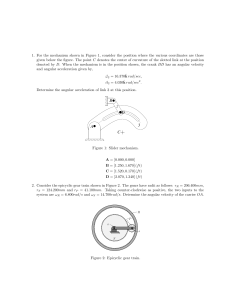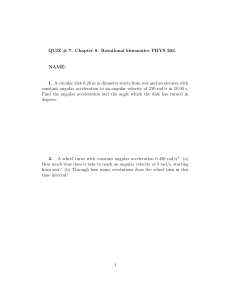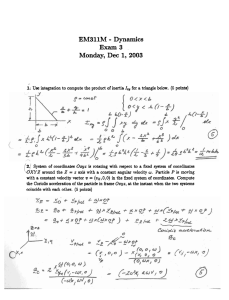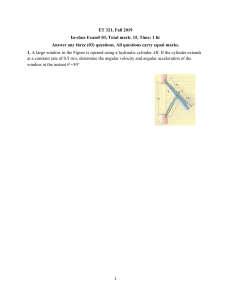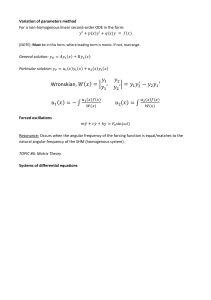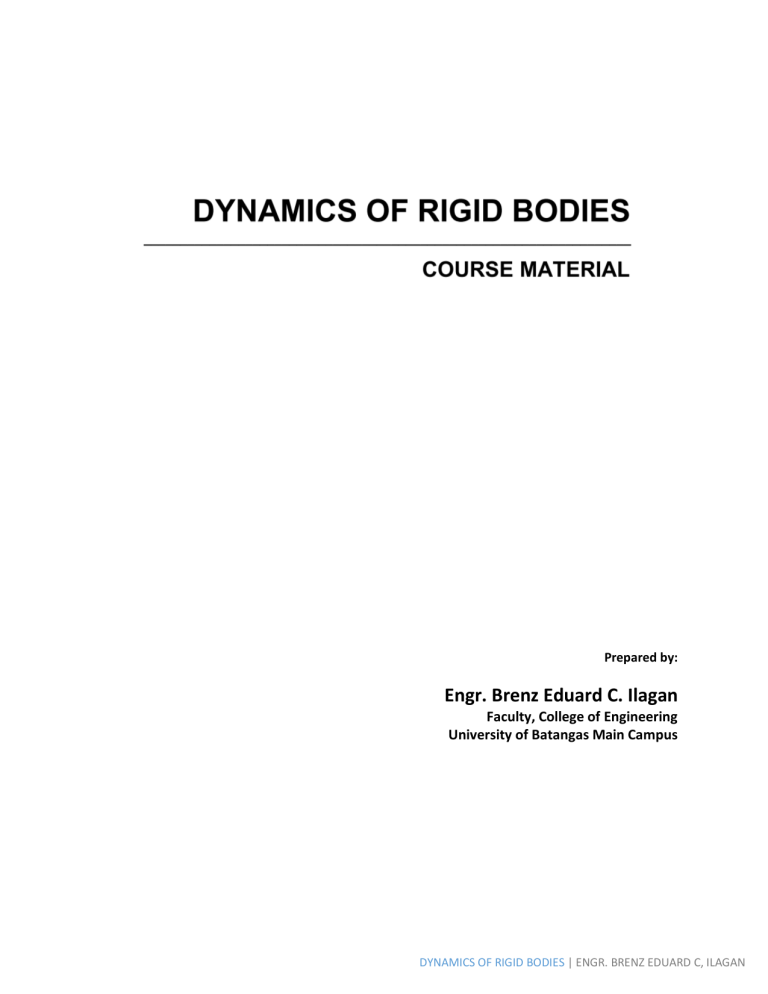
Prepared by: Engr. Brenz Eduard C. Ilagan Faculty, College of Engineering University of Batangas Main Campus DYNAMICS OF RIGID BODIES | ENGR. BRENZ EDUARD C, ILAGAN Session 4 Rotation In this session, you will get to know more about the concepts of dynamics of rigid bodies and other engineering science. By the end of this session you should be able to: 1. Analyze motion of a rigid body in a circular path with its center on a fixed straight line called the axis of rotation. 2. Understand the kinematics characteristics of rotation which are the following: angular displacement, angular velocity and angular acceleration. Lecture: ROTATION ABOUT A FIXED AXIS When a body rotates about a fixed axis, any point P located in the body travels along a circular path. To study this motion it is first necessary to discuss the angular motion of the body about the axis. Angular Motion Since a point is without dimension, it cannot have angular motion. Only lines or bodies undergo angular motion. For example, consider the body shown in Fig. and the angular motion of a radial line r located within the shaded plane. Angular Position At the instant shown, the angular position of r is defined by the angle Ө, measured from a fixed reference line to r. Angular Displacement The change in the angular position, which can be measured as a differential dӨ, is called the angular displacement. This vector has a magnitude of d Ө, measured in degrees, radians, or revolutions, where 1 rev = 2 π rad. Since motion is about a fixed axis, the direction of dӨ is always along this axis. Specifically, the direction is determined by the right-hand rule; that is, the fingers of the right hand are curled with the sense of rotation, so that in this case the thumb, or dӨ, points upward, Fig. 16–4a. In two dimensions, as shown by the top view of the shaded plane, Fig. 16–4b, both Ө and dӨ are counterclockwise, and so the thumb points outward from the page. Angular Velocity The time rate of change in the angular position is called the angular velocity ω(omega). Since dӨ occurs during an instant of time dt, then, DYNAMICS OF RIGID BODIES | ENGR. BRENZ EDUARD C, ILAGAN This vector has a magnitude which is often measured in rad/s. It is expressed here in scalar form since its direction is also along the axis of rotation, Fig. 16–4a. When indicating the angular motion in the shaded plane, Fig. 16–4b, we can refer to the sense of rotation as clockwise or counterclockwise. Here we have arbitrarily chosen counterclockwise rotations as positive and indicated this by the curl shown in parentheses next to Eq. 16–1. Realize, however, that the directional sense of ω is actually outward from the page. Angular Acceleration The angular acceleration α(alpha) measures the time rate of change of the angular velocity. The magnitude of this vector is Using Eq. 16–1, it is also possible to express α as The line of action of α is the same as that for ω, Fig. 16–4a; however, its sense of direction depends on whether ω is increasing or decreasing. If ω is decreasing, then α is called an angular deceleration and therefore has a sense of direction which is opposite to ω. By eliminating dt from Eqs. 16–1 and 16–2, we obtain a differential relation between the angular acceleration, angular velocity, and angular displacement, namely, CONSTANT ANGULAR ACCELERATION If the angular acceleration of the body is constant, then the following equation, when integrated, yield a set of formulas which relate the body’s angular velocity, angular position, and time. These equations are similar to one used for rectilinear motion. The results are: DYNAMICS OF RIGID BODIES | ENGR. BRENZ EDUARD C, ILAGAN Motion of Point P. As the rigid body in Fig. 16–4c rotates, point P travels along a circular path of radius r with center at point O. This path is contained within the shaded plane shown in top view, Fig. 16–4d. Position and Displacement. The position of P is defined by the position vector r, which extends from O to P. If the body rotates du then P will displace ds = r dӨ. Velocity. The velocity of P has a magnitude which can be found by dividing ds = r du by dt so that As shown in Figs. 16–4c and 16–4d, the direction of v is tangent to the circular path. Acceleration The acceleration of P can be expressed in terms of its normal and tangential components. Applying Equation, The tangential component of acceleration represents the time rate of change in the velocity’s magnitude. If the speed of P is increasing, then at acts in the same direction as v; if the speed is decreasing, at acts in the opposite direction of v; and finally, if the speed is constant, at is zero. The normal component of acceleration represents the time rate of change in the velocity’s direction. The direction of an is always toward O, the center of the circular path. DYNAMICS OF RIGID BODIES | ENGR. BRENZ EDUARD C, ILAGAN ILLUSTRATIVE PROBLEM NO. 1 The rim of a 50in wheel on a brake shoe testing machine has a speed of 60mph when the brake is dropped. It comes to rest after the rim has traveled a linear distance of 600ft. What are the constant angular acceleration and the number of revolutions the wheel makes in coming to rest? DYNAMICS OF RIGID BODIES | ENGR. BRENZ EDUARD C, ILAGAN ILLUSTRATIVE PROBLEM NO. 2 When the angular velocity of a 4ft diameter pulley is 3 rad/sec., the total acceleration of a point on its rim is 30fps^2. A.) Determine the normal acceleration of the pulley at this instant. B.) Determine the tangential acceleration of the pulley at this instant. C.) Determine the angular acceleration of the pullet at this instant. DYNAMICS OF RIGID BODIES | ENGR. BRENZ EDUARD C, ILAGAN ILLUSTRATIVE PROBLEM NO. 3 The rotation of a pulley is defined by the relation is defined by the rotation Ө = 2t^4 – 30t^2+6 where Ө is measured in radians and t is in seconds. a.) Compute the value of the angular displacement Ө when t = 4sec. b.) Compute the value of the angular velocity at the instant t = 4sec. c.) Compute the value of the angular acceleration at the instant t = 4 sec. DYNAMICS OF RIGID BODIES | ENGR. BRENZ EDUARD C, ILAGAN ILLUSTRATIVE PROBLEM NO. 4 The angular acceleration of a pulley which will rotate from rest is increased uniformly from zero to 12 rad/s^2 during 4 sec., and then uniformly decreased to 4 rad/s^2 during the next 3 sec. a.) Compute the angular velocity at the end of 7 sec. b.) Compute the angular displacement at the end of 4 sec. DYNAMICS OF RIGID BODIES | ENGR. BRENZ EDUARD C, ILAGAN
